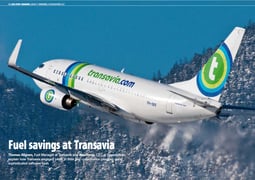Why do you need accuracy to earn pilots’ trust?
When we started working on fuel efficiency based on Big Data analytics, we involved airlines and especially pilots from day one.
Presenting our ideas and results to pilots very early in our development stage has proven to be an extremely demanding but also extremely rewarding decision that we have never regretted since then.
We were challenged on how we considered runway conditions to decide if idle reverse thrust is applicable, how we computed the benefit of a Continuons Descend Approach (CDA), if it considered headwind and shortcuts in the calculation, etc., etc.
It was challenging but we listened, and we worked hard on building performance models that consider all these parameters.
- Pilots need accurate data
Pilots know that their job is not a routine job. They know that each flight is different: that payload, individual aircraft tail performance, weather, traffic or routing are different on each flight.
That's why if you measure the benefit and remaining potential of each procedure, you should embed all this complexity in your algorithms with advanced performance models. Statistics will not be enough.
The following two trajectories represent the final approach of the same aircraft (a B737-800) arriving at the same airport and same runway. None of them was a CDA as they both had leveled steps. Yet, on the first arrival, the excess fuel compared to a CDA was only 5kg because it was almost a CDA (it had only a single step of 5 nm with limited thrust), while the excess fuel for the second one exceeded 180kg due to three steps totaling 41 nm.
Excess fuel compared to CDA: 5kg

Excess fuel compared to CDA: 180kg

Figure 1 : Example of 4D views shared with pilots in SkyBreathe MyFuelCoach™
(blue means low fuel consumption; green, yellow and red means high fuel consumption)
And when you give pilots recommendations on fuel saving, you should also fully support the airline SOP’s and consider all the parameters that they depend on:
- the chosen approach,
- the airport restrictions,
- the weather conditions, etc.
- Accuracy brings trust
Pilots can be presented with all the data you want. At the end, they will decide how much fuel they take, which parameters they put in the FMS, which maneuver they execute or not.
If the figures you share with them are inaccurate, if they don't consider the conditions of the day, or if they don't match their own personal experience, they will most likely disregard them.
You will have failed engaging them and you will have lost all the benefits of providing data to them.
On the contrary, if the figures and advices are trustworthy, then you'll get their respect, they'll use the data because it's relevant and helps them perform better.
And that's when you'll reap the full benefits of a fuel saving program.

Figure 2: This figure shows the progress in Engine Out Taxi In application
(together with the fuel saved) at Norwegian after the introduction of MyFuelCoach™
- Seeing is believing
Beyond the accuracy of the data, the way you present information to pilots is key. Flight folders and FMS are not very sexy, to say the least.
You can use more engaging visuals that are more in line with modern life experience: graphs, interactive 3D view, etc. Make it concrete and fun and they’ll love it.

Figure 3 : SkyBreathe MyFuelCoach™
READ MORE
You want to learn more about how airlines earn pilot trust, discover how Transavia better engaged their pilots:




